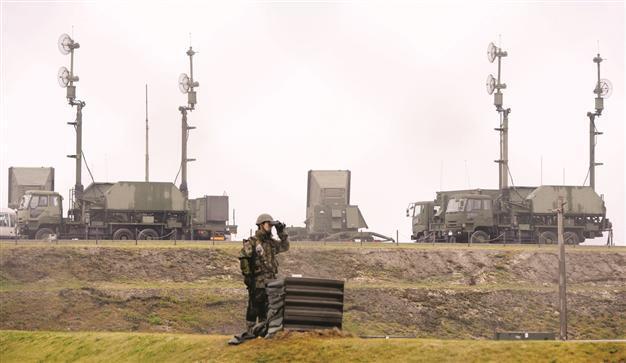Japan eyes wider role in US policy
CİHAN ÇELİK \ ANALYSIS

A Japanese soldier stands watch near military equipments at Japan Air Self-Defense Force’s base in Okinawa. On the eve of Noda’s visit to the US, the Obama administration shifts 9,000 US Marines on Okinawa to Guam and other parts of the Asia-Pacific region.
Initiating a new security strategy that is shifting from the turmoil-stricken Middle East to the safer but enigmatic Asia-Pacific, the president of the United States recently hosted a high-profile leader from the region, whose embattled government is desperate to boost its alliance with Washington.With his visit to the U.S., Prime Minister Yoshihiko Noda has become the first Japanese leader to be hosted at the White House since his Democratic Party of Japan (DPJ) came to power in the fall of 2009, ending over the 50-year rule of the center-right Liberal Democratic Party (LDP).
Battling a perfect storm of crises at home, Noda’s fragile leadership faces the daunting task of putting the world’s third-largest economy back on track, in a country struggling to cope with uphill economic, political and security battles following the 9.0 magnitude Tohoku earthquake in 2011. While both Washington and Tokyo appear keen to strengthen their ties in the face of the rising influence of China, Russia and India, Noda’s visit also marked a significant change for Japan’s foreign policy, because his DPJ ended the long rule of the LDP by promising voters a more Asia-focused policy, in place of the traditional U.S.-centric one.
That promise, however, failed to save Noda’s two Democratic predecessors, and he is now the sixth prime minister in six years in a country which has been accustomed to a more stable political environment. The Noda leadership must have seen that it cannot grapple with the rising Asian giants without help from the U.S. “I would like to exchange views candidly on the vision of a future U.S.-Japan alliance. I want the meeting to be fruitful so that the public can see clear results,” Agence-France Presse quoted Noda as saying in Tokyo.
Wider security pact
On the eve of Noda’s visit to Washington, the U.S. administration announced a defense agreement with the Tokyo government which required the shifting of nearly 9,000 U.S. Marines on the Japanese island of Okinawa to the U.S. territory of Guam and other parts of the Asia-Pacific region. At first blush, the Okinawa deal seemed as though it would be a relief for both Tokyo and for locals on the island, because the infamous presence of U.S. troops has created anti-American sentiment not only there but across the nation. However, a detailed analysis reveals that the accord would serve to spread U.S. forces more widely throughout the Asia-Pacific.
As part of the defense agreement, the two countries would consider setting up their first permanent joint training bases in Guam or the nearby Northern Mariana Islands. The move would carry heavy symbolism for Japan, which has been officially pacifist since the end of World War II, but also recently took steps to boost its armed forces amid threats from China and particularly from North Korea.
Fighting rising unemployment, growing national debt and a social security crisis, the Noda government is not just pinning its hopes on the U.S., but also on another regional ally, India, which is also at odds with the mounting Chinese influence. Assigning his top officials to a visit to New Delhi, Noda clearly showed his interest in closer political, security and economic cooperation between the two nations. (See details on p. 12)
The question that now lingers is which steps other powerhouses, such as Russia and China, will consider taking after witnessing the cementing of ties between the capitals of Tokyo, New Delhi and Washington. Those steps and their counter-steps will shape the climate in the relatively quiet Asia-Pacific region in the coming years.
















